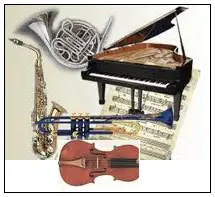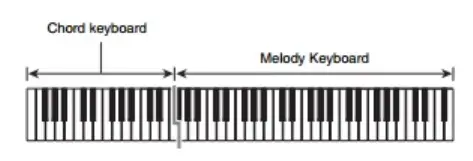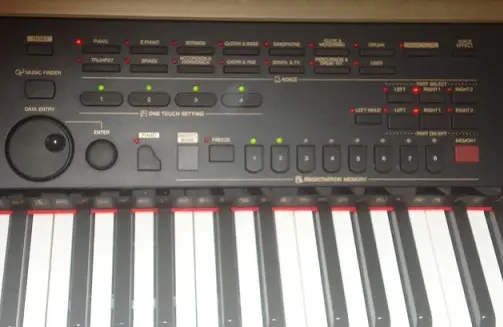
Introducing Electronic Piano Keyboard: The Musical styles & accompaniments is what makes the portable electronic keyboards so popular.
How to be a One Man Orchestra!
Styles Are Fun to Use
The presence of hundreds of built-in accompaniments and sounds is what makes the musical keyboard a very popular instrument.
The built-in accompaniments, also known as musical styles or rhythms or auto accompaniments make the electronic keyboard a one man orchestra.
These musical styles cover various musical genres and are meant to accompany any type of song that you play.
The accompaniments normally follow the chords which your left hand plays while your right hand plays the melody instrument of your choice.
All the portable electronic keyboards have the standard styles like Pop, Rock, Jazz, Latin, Foxtrots, Waltz, Swing, etc. and the more contemporary types like techno, house, jungle, Arabic, and Indian.
Buying a Keyboard/Piano with Music Styles
Whether you are looking for ways to improve your keyboard playing abilities or want something to impress your friends and family members, or wish to play the instrument like a professional, getting a good keyboard is the first step.
The high-end arrangers come with some cool styles that can be used for creating remixes, or for arranging a song, or for learning to arrange, or purely just for fun.
As far as the keys are concerned, there’s already so much information on this site. You may want to check this article for more on the keyboard action.
You could always practice on a synth keyboard, but then it may not be very easy to switch from non-weighted to weighted keys; whereas doing the other way around is more of adaptation.

The Accompaniment Tracks
The accompaniment is actually a group of tracks playing various instruments. The tracks normally play the instruments like Drums, Bass, Piano or Guitar, Strings, woodwind, brass or any other melody instrument.
You can mute any of these tracks and practice playing that muted instrument along with the other tracks.
These are excellent for learning how a song is built from scratch, and also to know how the various musical genres sound.
This is really the beauty of an electronic piano as even the cheapest ones would give you hundreds of styles and voices, that will definitely help to further your music education.
The Standard Buttons
The piano auto-accompaniment section is where you find all the relevant buttons.
Usually, a dial button exists on most keyboards that can also be used to browse through the various rhythms numbers, until you find the one that you want to use.
Just select your favorite rhythm and the matching accompaniment (drums, bass, guitars) will play automatically when you play a chord.
Most of the instruments have buttons like Start, Stop, Intro, Ending and Fill-ins which basically lets you create realistic and interesting arrangements while playing.
The Fill-ins buttons lets you create slight variations of the accompaniment with the press of a button.
The Tempo button lets you speed up or slow down the accompaniment. In Pianos (without styles), that button is usually used to slow down or speed up the metronome.
Chord Fingering Modes
You also get various chord fingering modes (used to start the accompaniments), the more common ones being:
- Chord section on the left of the keyboard
- The entire range of keyboard can be used for chords

Which Chords can be played with the accompaniment ON?
Most arrangers let you play the following types of chords, when one of the modes is ON:
- Major Chords
- Minor Chords
- Seventh Chords
- Minor Seventh Chords
You also find a “synchro-Start” button that starts the accompaniment the moment you play a chord.
Need More Styles?
The more accompaniments you listen to, the more you understand about the arrangement of a song and how the various instruments work together. It lets you become more creative.
It is good if your instrument has a large number of styles!
Most of the high range keyboards can be updated with the latest styles, available on floppy disk or downloadable from the Internet.
You can even create your own styles on most of the electronic keyboards. As you become more skilled at playing the keyboards and using its features, try creating your own styles.
Professional Arrangements
The styles available on the pro keyboards are actually recordings of top class musicians performing live.
And that is why professional composers have such keyboards at their disposal, so that if they have a tight deadline to meet they will just use the styles from these pro keyboards.
That means they just have to work on the melody and chords, and their entire sequence would be ready in no time, comes in handy for the working musicians.
There are also additional advantages of having a good collection of music styles on your keyboard.
How to Record Your Own Musical Styles on Piano Keyboard
Though a Digital Keyboard/Piano has many built-in musical styles, you can still create your own unique musical styles. Learn how to create one.
Have you tried recording your own songs on your digital music keyboard? Do you know a digital musical instrument can let you record individual tracks of a song?
A digital musical keyboard lets you record original User styles which can be used for auto accompaniment in the same way as the preset musical styles.
User style data can also be saved to and loaded from external storage devices like floppy disks, usb drives.
Different Sections in a Musical Style
Every musical style has different sections. The most common sections found on a digital musical instrument are:
- INTRO section
- MAIN section
- FILL-in sections
- Ending section
So if want to create your own musical style, you will need to create these different sections.
Learn to Arrange Songs
When creating music, thought melody is an important aspect and everybody remembers the melody, the fact is that a lot of effort goes in creating the arrangement for any song.
And if you have ever creating your own music, you will realize that at times creating the melody is the easier part but it is not at all easy to build a structure around the melody.
So it’s important that you out in time to learn how to create your own arrangement, and what better place to do it that your digital arranger keyboard.

How to Create a User Style? Different Methods!
There are a couple of ways in which you can do this.
- Style Recording Using Built-in Rhythm
You can create a User style by using the internal style data as a starting point. With this operation you can create your own original rhythm patterns by editing existing rhythm track data from a preset style.
Select a preset style that is closest to the type of style you want to create, and record the auto accompaniment patterns to each section.
- Style Recording – Each Track Separately
Musical styles usually have the following tracks – Bass, Phrase, Pad, and chord tracks. So if you don’t want to use an existing style to start with, record each of these tracks separately.
metronome while recording the tracks to get the timing right, and don’t forget to quantize the notes.
After your musical style is created, you can assign it a name of your choice for easy recall.
To Conclude
The portable electronic keyboard is one of the most versatile electronic musical instruments. The hundreds of built-in musical styles and accompaniments lets you play any song, with all its arrangements, all by yourself. A very useful tool for your overall understanding of music!
Once you are past the beginner’s stage, you may want to experiment more with your digital keyboard piano. Use your music keyboard to create your own unique musical styles and increase your creativity. You will need this skill when you want to arrange music for your own compositions.
Read here for a complete guide on piano and keyboard instruments.
External Links
Common Styles
Here are some of the common styles found on most arrangers. There could be variations of these, and also a few more.
Alternative: Alternative Rock, Grunge, Hardcore Punk, Hard Rock, Indie Rock, New Wave, Progressive Rock, Punk
Blues: Classic Blues, Contemporary Blues, Country Blues, Electric Blues
Children’s Music: Lullabies, Sing-Along, Stories.
Classical: Baroque, Chamber Music, Choral, Opera, Orchestral, Renaissance, Romantic, Waltz
Country: Alternative, Bluegrass, Contemporary, Country Gospel, Honky Tonk, Traditional Bluegrass, Traditional Country
Related Posts
Read more on Music Arranger Keyboards, including popular brands
Back to Home page from electronic piano keyboard Accompaniments
KeytarHQ editorial team includes musicians who write and review products for pianists, keyboardists, guitarists & other musicians. KeytarHQ is the best online resource for information on keyboards, pianos, synths, keytars, guitars and music gear for musicians of all abilities, ages and interests.



Leave a Reply